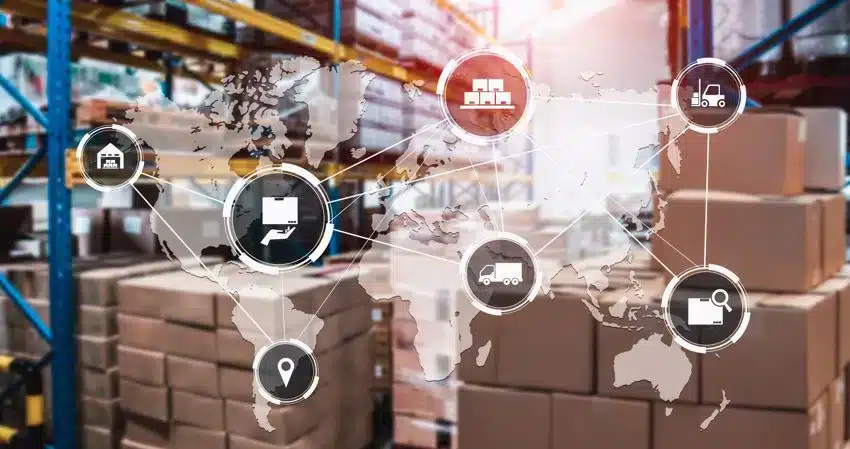What goes into your supply chain? On one hand, your company's logistics operations consist of very real shipments being moved between various locations. But there's another side to these processes — the information generated by every transaction and movement of goods between parties.
In today's digitally enabled business climate, a company's ability to turn data into fuel for insights and decision-making may be an important determinant of overall success. This is why business intelligence (BI) now has a major role to play in the increasingly digital supply chain. If your organization isn't already analyzing logistics data, it's time to start, because your competitors may have made this leap.
Once you dig into the supply chain data generated by freight and shipping agreements and the everyday transactions that occur between your organization and its partners, you may be surprised at the depth of insights you can mine.
Supply chain business intelligence has had a major impact on companies of all sizes — find out how.
What's the Importance of Business Intelligence in the Supply Chain?
BI is an important component of supply chain management because without these systems providing insights and detailed reports based on data, you're relying heavily on intuition. There is a better, more accurate way to make both big-picture strategic decisions and everyday choices.
As CIO Insight explained, the power of a business intelligence solution or advanced analytics system comes from the way leaders can now visualize each piece of their operations. All the digital transactions occurring every day leave a trail of data, and by analyzing that content, you can gain a non-siloed vision of how goods are moving between your business and its partners.
This visualization extends to the day-to-day facts that can help your organization make intelligent, proactive and informed decisions that will maximize value. By understanding the real-time supplier performance, you may even realize that there are problems that need addressing within the supply chain, for instance, partner organizations failing to meet reliability or schedule targets.
Data in the Supply Chain: More Important than Ever
The importance of supply chain analytics has only increased in recent years. From the earliest days of the COVID-19 pandemic, weak links in global logistics networks have been thrown into stark relief. Breakdowns have afflicted every stage of the supply chain, from raw material shortages and factory shutdowns to backlogs at ports and a lack of available personnel in overland transit.
While some conditions have improved, others haven't, and the added perspective brought on by the breakdowns has lingered. Leaders are now thinking in terms of reinforcing their logistics practices to favor resilience and redundancy.
Analytics and BI software can serve as the essential early warning system, pointing out where potential weak links exist, as well as helping organizations make critical decisions more accurately and confidently. Some businesses have already committed to a data-driven approach to supply chain oversight, meaning you may be falling behind if you haven't made a similar evolution.
Besides straightforward strategic insights, you can also derive specific financial calculations from your use of BI and analytics. For example, by calculating the true landed costs of shipments, you can determine where your freight and shipment agreements are optimized — and where they need improvement.
Organizations of all sizes are discovering the importance of optimizing their logistics costs, and they're finding that BI is the key.

How Do Supply Chain Analytics Systems Work?
Supply chain analytics systems perform a simple but impactful function: They turn everyday information into extraordinary insights. Understanding the way business intelligence software converts inputs into powerful fuel for decision making can show just how and why these solutions are so valuable for modern organizations.
- The inputs: What are the data sources for today's algorithms? Anything and everything. Your company's internal platforms, such as customer resource management (CRM) and enterprise resource planning (ERP), are well-stocked with useful data. Your supply chain partners and customers also generate information you can use — since every interaction today is conducted digitally, they all create input for analytics algorithms to parse.
- The analysis: What would you like to know about the performance of your supply chain? There are numerous useful analytical models available in today's business intelligence systems. These range from determining the rate of late or on-time shipments to calculating the relative operational efficiency of different distribution facilities or revealing the risk associated with certain sourcing, manufacturing or production processes.
- The output: Insights from analytics systems are only truly impactful if decision makers can view and understand the results. This is where dashboards and reports come in. Through a series of customized or premade visualizations, analytics platforms can inform your company's stakeholders of the most important variables, whether that means costs, timelines, risks or anything in between.
There's nothing overly complicated about integrating analytics into the supply chain. These systems have already become standbys in other departments, largely because it's possible to integrate a business intelligence solution with the digital platforms that power everyday data management and communications.
Leadership with Analytics in Mind
Putting a BI solution in place is just step one in creating a modern, data-driven and digital supply chain. Stakeholders have to change the way they make everyday decisions to factor in these platforms' results. Failing to adapt to the presence of analytics can negate their impact, so it's important to update your mindset alongside your technology.
A Supply Chain Digital report highlighted the connection between supply chain analytics output and business objectives. First, leaders calculate their overall landed costs based on a wide variety of factors, ranging from projected customer demand to ideal inventory levels and manufacturing capacity. Then, they turn those calculations into value-driven informed decisions.
By drilling down through analytics, you may find that some contracts are falling short of their potential, or you may determine opportunities to renegotiate for favorable terms. Internal processes, too, can change based on projections from your BI and analysis efforts. When these algorithms form a solid basis for your strategic choices, your overall performance stands to benefit.
Discover the value that comes from powerful, accurate BI embedded in the supply chain.

How Has Supply Chain Business Intelligence Evolved?
Business intelligence is, in some ways, the same process it's been for decades. The concept of algorithms that turn raw data into valuable insights is an old one, and it has served leaders well. Recent years have seen an evolution in this software, however, and it's worth considering how your business can benefit from not just using supply chain BI tools but the latest and greatest offerings.
So, what defines the latest generation of BI and analytics technology? In short, every element of these systems has grown to incorporate new capabilities and deliver optimal results. Recent developments include:
- Increased capacity to deal with diverse data sets: Part of the division between legacy BI and modern big data analytics comes from the kinds of inputs that systems can parse and analyze. In the past, only cleansed, structured data sets would do. Now, large, unstructured content can fuel analysis, allowing organizations to plumb every corner of their supply chain operations.
- Improved speed and real-time capabilities: Analyzing historical data to create projections about future performance is a fine way to conduct analytics, but modern systems can do more. By breaking down real-time streams of input, these algorithms can give insights that are valuable in the moment and allow organizations to directly adjust their tactics for optimal results.
- Optimally user-friendly and customizable dashboards: Evolving dashboards, which enable leaders to pull up the views that matter the most to them presently, are an essential component of modern analytics. These ensure that the latest systems aren't just more powerful than previous generations of the technology; they're also more practical.
Up and down the global supply chain, decision makers can call on capable modern analytics systems to make optimal choices. As these systems have developed the capacity for dealing with deeper supply chain data sets while also growing faster and more accessible, it's become clearer that they can differentiate leading and trailing performers.
Modern business issues require up-to-date supply chain business intelligence.
Ready To Get Started with Supply Chain Business Intelligence?
Just as there is a difference between legacy and modern BI software solutions, there are also different levels of performance between partner organizations that can provide these capabilities. The right match can elevate your company's supply chain results, while a less suitable option may fail to have a significant impact.
Making an effective selection may mean working with an organization that understands the supply chain, rather than an all-purpose vendor. Instead of treating BI as a discrete system, such a partner can offer a unified supply chain technology platform that combines overall logistics management capabilities with insightful analytics dashboards that suit real-world supply chain scenarios.
This is the level of service you receive when dealing with Zero Down Supply Chain Solutions. Our platform is specifically designed to capture diverse data streams from throughout all your supply chain carrier agreements into cohesive and actionable insights. The platform offers 50 dashboards and more than 70 report types, along with the capability to customize those views or drill down for a remarkable degree of data detail.
Zero Down Supply Chain Solutions is a partner that understands the way modern supply chains operate, while acknowledging the diverse objectives and approaches that animate companies today. The proprietary FreightOptics Transportation Spend Management software suite doesn't just offer a high level of BI performance, it's fine-tuned to provide optimal visibility into every corner of the global supply chain, helping you optimize your costs and operational efficiency throughout your multifaceted logistics operations.
Ready to get started building a more intelligent supply chain? Contact us.




